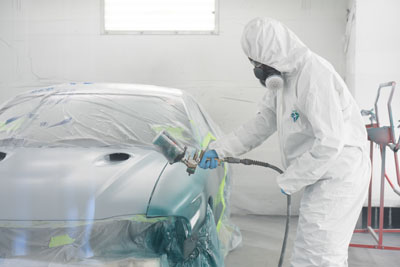Alexander Graf, an alum of the program who now teaches it, guides students through project cars that come through the college’s automotive service desk.
Written by Autobody News Staff
Published Dec. 5, 2023
A 1997 Ford Mustang Cobra is getting the chance to shine again, thanks to students in Alexander Graf’s auto body technology classes.
Gone is the faded paint, replaced with metallic green to make it look like new again. The Cobra is one of the many projects going on in SUNY Morrisville’s auto body technology program in New York under the leadership of Graf, instructional support assistant.
A graduate of SUNY Morrisville’s auto body technology in 2016 and former entrepreneurship and small business management 2018 programs, Graf went on to earn his master’s degree from SUNY Poly. His breadth of experience includes vintage Volkswagen restoration and early 1900s Cadillac restoration. An I-CAR certified instructor in GMA MIG welding, he is also a technician in painting and non-structural repair.
The Mustang makeover is the latest project for Graf and students in his advanced auto body refinishing and structural measurement class, where learning includes techniques required to properly repair multi-coat paint finishes, structural and non-structural analysis and collision repair of unibody vehicles.
Students prepped the Mustang for five weeks, before painting it in the college’s Garmat paint booth.

“For me, this is my favorite part,” said Sean Adjei, of White Plains, NY, one of three students working on the car, along with Vincent Spampinato and Kendra Wilkinson.
Adjei’s avid interest in painting model kits drove his interest in SUNY Morrisville.
“I want to work in a body shop someday,” he said. “I am learning that cars are shaped differently so you have to paint them differently. And I am also learning about different kinds of paint.”
Projects, which come through the college’s automotive service desk that is staffed by students, are selected according to what applies to the current curriculum.
Requests come in big and small, ranging from fixing dents to restoring hoods and fenders. Amid an assemblage of car parts are spare fenders Graf has students dent then fix.
Painting the Mustang is just a portion of the hands-on experience students are gaining in class. They also study teardown and reassembly, frame straightening, metalwork and refinishing, while taking additional requisite courses that cover topics needed to pass ASE examinations in the areas of collision repair and refinishing. The program also includes a 10-week summer internship in collision repair.
“I incorporate as much of the industry as possible into the program,” Graf said. “We work a lot with PPG paint products, 3M products and cover a broad range of topics to introduce and expose students to different career potentials including paint work, frame repair, estimating and start to finish from disassembly to preparing for customer pickup.”
Students gain skills for their resume and the opportunity to earn three certifications from I-CAR in non-structural repair, welding and paint.
Faculty, who are experts in their field, round out the experience, as well as automotive facilities, which are up to speed with the ever-changing auto industry, offering the latest in technology and equipment.
The 14,000-square-foot auto body technology building houses the most current tools and equipment for collision repair and metal fabrication. Set up as a real-world auto body shop, students perform live laboratory work and help staff a parts department and live service desk to gain experience with repairs, refinishing and estimating.
Features that deliver a modern refinishing environment supported by industry leaders include a frame and body laser alignment system, superior air purification equipment, mixing system, in-floor heating and an environmentally friendly Garmat crossdraft paint spray booth, which can dry a coat of paint in half the normal time.
Graf continuously seeks grants for his program to augment and update equipment, recently receiving a $6,000 Benchmark Grant from the Collision Repair Education Foundation for supplies that will support the auto body program.
Graduates have the option to transfer into SUNY Morrisville’s bachelor’s degree program in automotive technology or the bachelor of business administration (BBA) degree program in automotive management.
For more information about SUNY Morrisville, visit www.morrisville.edu.
